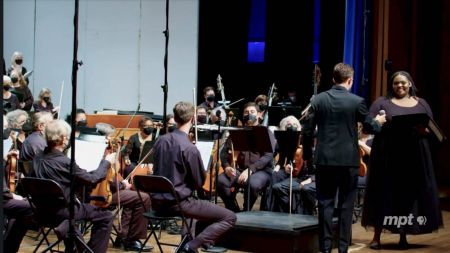Dreamer Album Review by Textura
Dreamer, Baltimore Choral Arts' recent recording release, recently received a review by Textura. You can read the full review here.
From the article:
"The choir's singing [...] doesn't lack for impact, however, as demonstrated by its powerful delivery in “Do Right”; it doesn't hurt either that the music's driven by ostinato rhythms, surging strings, and syncopated snare and tympani drumming. The drama of “Moral Growth” is intensified when Barnes accompanies the choir and orchestra with a rattle reminiscent of the kind used to warn escaped enslaved people that danger was near. The American spiritual style Barnes adopts for “Death or Liberty” bolsters the material's impact, and much the same could be said for the uplifting spirit with which “Every Great Dream” is imbued. Portraits: Douglass and Tubman rewards on many levels, variety of presentation in particular. Alternating between narration and choral singing proves engaging, as does the score's ranging between classical, jazz, and theatre and its incorporation of spiritual music. While the work addresses the injustices Black people have historically endured, its message is ultimately about hope for the future.
As far as the Mozart work is concerned, purists can relax as Clark hasn't compromised its integrity; in fact, in liner notes the conductor states, “In an effort to be as inconspicuous as possible, my edits are brief and infrequent” and then lists the changes made, from adding an instrument to a section to beefing up an orchestral passage. Of course, no matter how credible a completion is, it can never be what Mozart himself would have created (begun in September 1791 but left incomplete when he died on December 5th, the work was finished by his student Franz Xaver Süssmayr).
With soloists Nola Richardson (soprano), Lucia Renata Bradford (mezzo-soprano), Steven Soph (tenor), and Enrico Lagasca (bass-baritone) aboard, Requiem rises to its customary lofty level. The choir and orchestra set the tone with the familiar solemnity and majesty of the “Introitus,” the singers and musicians soaring in tandem until the “Kyrie” and the explosive “Dies irae” animate the work with thrilling urgency. In Clark's estimation, the “Tuba mirum” and “Recordare” are “some of the most sublime works ever written for vocal soloists,” and it's hard to disagree when Lagasca, Soph, Bradford, and Richardson enter in succession in “Tuba mirum” and lift “Recordare” to magnificent heights; the weaving of their voices in the latter is especially memorable. After “Confutatis” pairs the wrath of tenors and basses with the angelic utterances of sopranos and altos, “Lacrimosa” opens with one of Mozart's most familiar string passages before handing the reins to Süssmayr (and Clark). It's open to debate thereafter as to whether it's Mozart or his pupil at the helm, though Clark argues that the “Sanctus” and “Agnus Dei” are “largely sourced from Süssmayr's mind.” The conductor also credits him for returning to the music of his teacher as the work advances towards its conclusion (see, for instance, “Benedictus” and “Lux aeterna”). In Süssmayr's defence, even those passages thought to be authored primarily by him remain true to the overall character of the work."
- Textura, 2024


